Stan Garfield's Blog, page 6
January 24, 2025
Knowledge Management Thought Leader 97: Art Murray
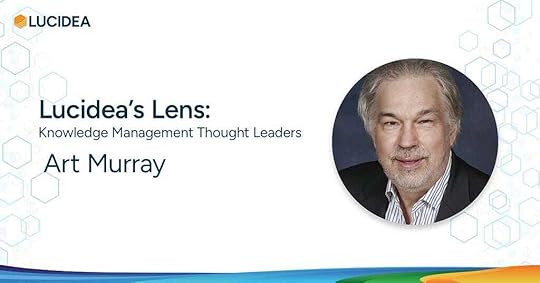
Art Murray is the CEO of his own consultancy, Applied Knowledge Sciences, and Chief Fellow of the Enterprise of the Future Program of the International Institute for Knowledge and Innovation. He is an author, speaker, workshop leader, and mentor in knowledge management and the enterprise of the future.
Art is the author of the KMWorld Magazine column “The Future of the Future.” His specialties include transforming traditional organizations into knowledge-sharing enterprises, human deep learning, building and curating e-bodies of knowledge, and organizational knowledge governance. Art focuses on building and curating digital bodies of knowledge, and human and machine knowledge integration and governance.
Here are definitions for five of Art’s specialties:
Curating : Collecting, selecting, and assembling existing information to make it more useful. This includes better organizing it, making it more findable, and making it easier to use.Digital Transformation: The cultural, organizational, and operational change of an organization, industry or ecosystem through a smart integration of digital technologies, processes, and competencies across all levels and functions in a staged and strategic way.Enterprise of the Future: A self-organizing, adaptive, learning network of knowledge workers, aimed at mutually achieving individual and organizational goals built four foundational pillars — leadership, organization, learning, and technology.Future of Work: An informed perspective on what businesses and other organizations need to know about how work could shift (given digitization and other trends), plus how workforces and workplaces can prepare for those changes, big and small. Knowledge Governance : The means by which the rules, norms, policies, guidelines, and actions for managing an organization’s critical knowledge are defined, applied, reconciled, and enforced.Art created the following content. I have curated it to represent his contributions to the field. For more about Art, see Profiles in Knowledge.
 Books by Art Murray
Books by Art Murray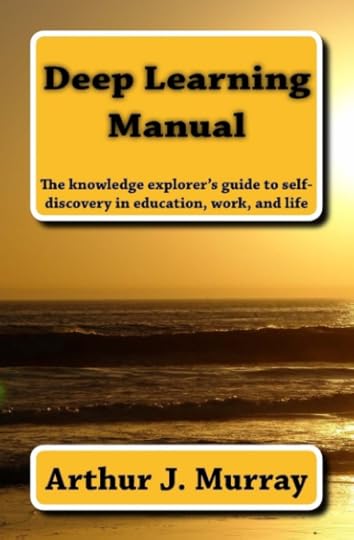
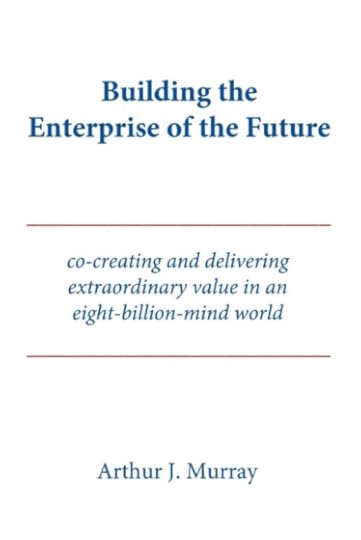 The four main steps to successful knowledge curation
The four main steps to successful knowledge curation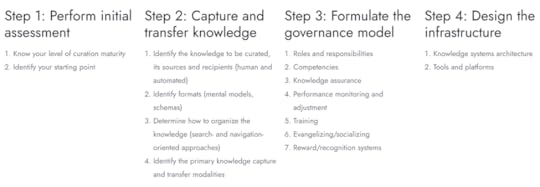 An 8-Step Framework for Organizational Knowledge Governance
An 8-Step Framework for Organizational Knowledge Governance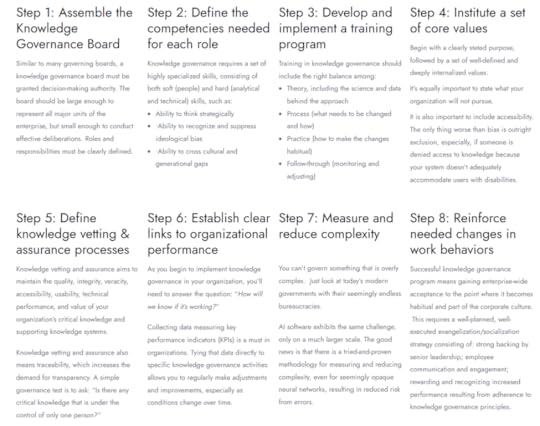 Building the Enterprise of the Future
Building the Enterprise of the Future [image error]
[image error]
January 17, 2025
Knowledge Management Thought Leader 96: Peter Morville
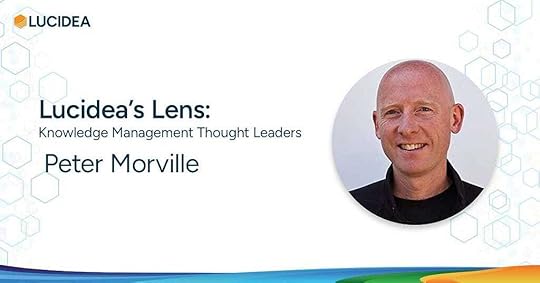
Peter Morville is a pioneer in the fields of information architecture and user experience, and has expertise in organizational strategy and planning. His specialties include findability, information architecture, user experience, usability, and systems thinking.
With Lou Rosenfeld, Peter applied principles of library science to solve issues of grouping and labeling on the early web. They co-authored Information Architecture for the World Wide Web, known as the “Polar Bear book,” the seminal book on information architecture. The two dubbed their work “information architecture,” although they did not mean it in the sense of Richard Saul Wurman’s use of the term, who according to Morville, “focused on the presentation and layout of information on a two-dimensional page. We focused on the structure and organization of sites.”
Here are definitions for five of Peter’s specialties:
Findability : The ease with which information can be found, meaning that users can easily find content or information they assume is present on a website.Information Architecture (IA): Organizing, structuring, and labeling content in an effective and sustainable way to help users find information and complete tasks. IA helps users understand where they are, what they’ve found, what’s around, and what to expect.Systems Thinking: A holistic approach to analysis that focuses on the way that a system’s constituent parts interrelate and how systems work over time and within the context of larger systems. Usability : Making products and systems easier to use, and matching them more closely to user needs and requirements. User Experience (UX) : A person’s perceptions and responses that result from the use or anticipated use of a product, system or service.Peter created the following content. I have curated it to represent his contributions to the field. For more about Peter, see Profiles in Knowledge.
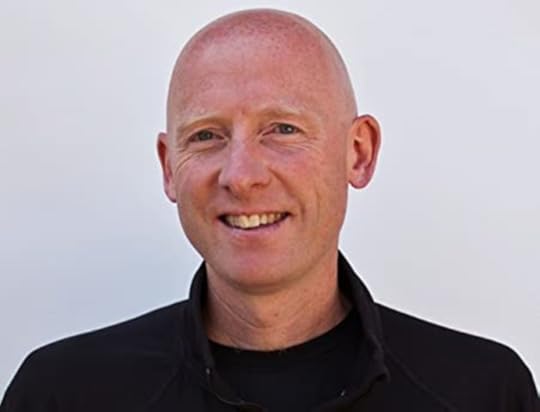 Books by Peter Morville
Books by Peter Morville Findability
Findability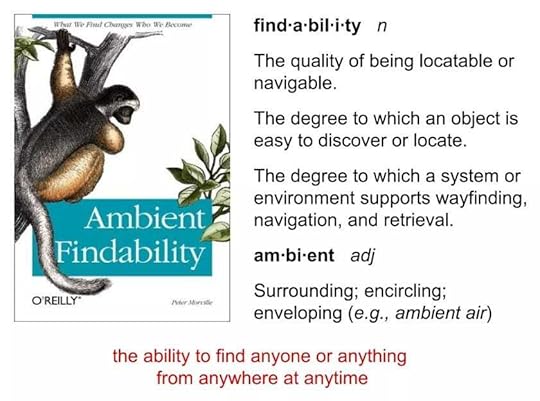
 The crossroads of Information Architecture and Knowledge Management
The crossroads of Information Architecture and Knowledge Management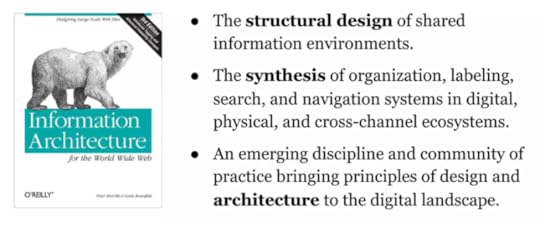

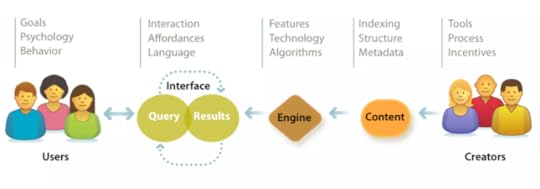
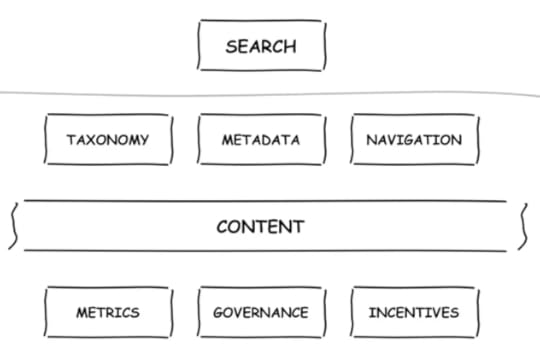 The Foundation of SearchUser Experience Honeycomb
The Foundation of SearchUser Experience Honeycomb Useful: We must have the courage and creativity to ask whether our products and systems are useful, and to apply our knowledge of craft + medium to define innovative solutions that are more useful.Usable: Usability is necessary but not sufficient.Desirable: Our quest for efficiency must be tempered by an appreciation for the power and value of image, identity, brand, and other elements of emotional design.Findable: We must strive to design navigable web sites and locatable objects, so users can find what they need.Accessible: Our sites should be accessible to people with disabilities (more than 10% of the population).Credible: Understand the design elements that influence whether users trust and believe what we tell them.Valuable: Our sites must deliver value to our sponsors.[image error]
Useful: We must have the courage and creativity to ask whether our products and systems are useful, and to apply our knowledge of craft + medium to define innovative solutions that are more useful.Usable: Usability is necessary but not sufficient.Desirable: Our quest for efficiency must be tempered by an appreciation for the power and value of image, identity, brand, and other elements of emotional design.Findable: We must strive to design navigable web sites and locatable objects, so users can find what they need.Accessible: Our sites should be accessible to people with disabilities (more than 10% of the population).Credible: Understand the design elements that influence whether users trust and believe what we tell them.Valuable: Our sites must deliver value to our sponsors.[image error]
January 10, 2025
Knowledge Management Thought Leader 95: Matt Moore

Matt Moore is a project/program manager, blogger, presenter, webinar host, and deep thinker. He has worked in the knowledge management field for over 20 years.
Matt developed knowledge management strategies, implemented content management systems, facilitated communities, developed classroom and eLearning programs, and developed marketing programs for corporations, government agencies and non-profits.
Here are definitions for five of Matt’s specialties:
Communities : Groups of people who share an interest, a specialty, a role, a concern, a set of problems, or a passion for a specific topic. Community members deepen their understanding by interacting on an ongoing basis, asking and answering questions, sharing their knowledge, reusing good ideas, and solving problems for one another. Content Management : Creating, managing, distributing, publishing, and retrieving structured information–the complete lifecycle of content as it moves through an organization. E-learning : Tools that enable the delivery and tracking of online training courses.Project Management: The discipline of planning, organizing, securing, managing, leading, and controlling resources to achieve specific goals. Strategy : A set of guiding principles that, when communicated and adopted in the organization, generates a desired pattern of decision making. The way that people throughout the organization should make decisions and allocate resources in order accomplish key objectives. A strategy provides a clear roadmap that defines the actions people should take (and not take) and the things they should prioritize (and not prioritize) to achieve desired goals.For more about Matt, see Profiles in Knowledge.
 Showing the Value of KMROI
Showing the Value of KMROI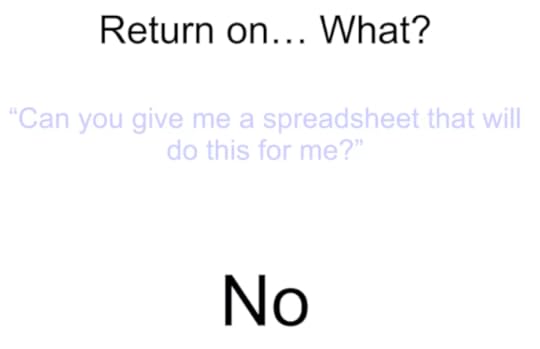 Metrics
Metrics
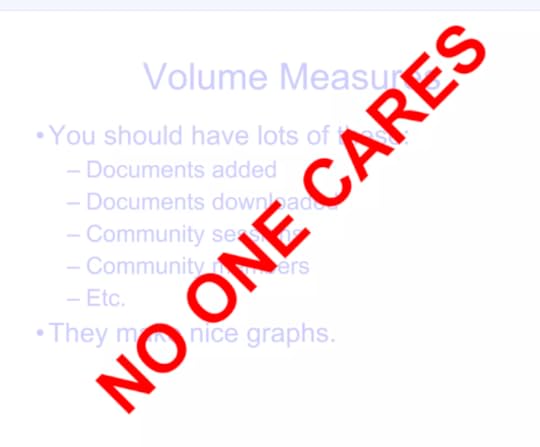 Value Drivers
Value Drivers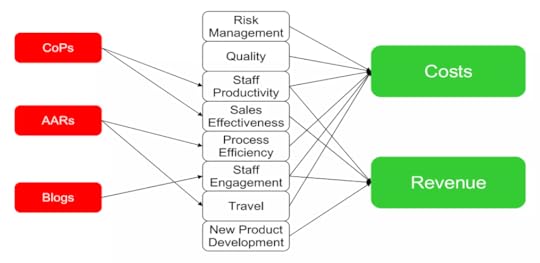 The Seven Deadly Sins of KMPride: “We don’t need to learn from anyone else, our operation is unique.”Envy: “XYZ’s KM, CoP, SNA program has just appeared in a news article. We would like one too.”Wrath: “I don’t want to WASTE time with any planning. Just do it!!!”Sloth: “I want all you underlings to share what you know. But don’t bother me about it.”Avarice: “Damn right I want to get organizational benefits. Invest to get them? Never…”Gluttony: “I want a million documents in the database. No! Make that a billion. More is better!”Lust: “I just love messing around with vendors & consultants. Meetings, workshops, everything. Just don’t hang around in the morning.”Attributes of a Good Community ManagerPASSIONATE about the domain & the development of a communityA PRACTITIONER of the domain themselvesRespected & liked by their PEERSAware & prepared for the organizational POLITICS they will encounterSkilled in facilitation PROCESS (be it virtual or real)Willing to PERSEVERE on this for months rather than daysKnowledge Management Vision
The Seven Deadly Sins of KMPride: “We don’t need to learn from anyone else, our operation is unique.”Envy: “XYZ’s KM, CoP, SNA program has just appeared in a news article. We would like one too.”Wrath: “I don’t want to WASTE time with any planning. Just do it!!!”Sloth: “I want all you underlings to share what you know. But don’t bother me about it.”Avarice: “Damn right I want to get organizational benefits. Invest to get them? Never…”Gluttony: “I want a million documents in the database. No! Make that a billion. More is better!”Lust: “I just love messing around with vendors & consultants. Meetings, workshops, everything. Just don’t hang around in the morning.”Attributes of a Good Community ManagerPASSIONATE about the domain & the development of a communityA PRACTITIONER of the domain themselvesRespected & liked by their PEERSAware & prepared for the organizational POLITICS they will encounterSkilled in facilitation PROCESS (be it virtual or real)Willing to PERSEVERE on this for months rather than daysKnowledge Management VisionI’m interested in what people complain about, because when things are working well, no one says anything. What would I like people to complain about? For example:
People can find me too easily. And they seem to know what I’m good at and what my experiences have been. It’s unnerving.We can quickly identify gaps in our information base — and I don’t like finding gaps.We seem to be sharing a lot of our IP among ourselves — and sometimes with our customers and partners. I’m worried about the leakage risks.Ignorance ManagementPart 1: Taxonomy & IrrelevancePart 2: Error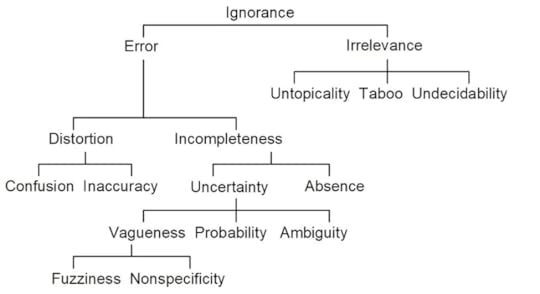 Untopicality
refers to things we feel we don’t need or want to know.
Taboo
refers to matters that are forbidden to us. I would split this between explicit and implicit taboos.
Undecidable
matters cannot be determined to be true or false.
Confusion
is mistaking something for something else.
Inaccuracy
amounts to misestimating something.
Absence
is missing information.
Probability
is uncertainty about whether something is true or whether an event will happen.
Ambiguity
refers to distinct possible states.
Fuzzy Vagueness
refers to fine-graded distinctions and blurry boundaries and is specific.
Nonspecific Vagueness
is simply as it says. Extra vague vagueness.Part 3: Scandignorance
Untopicality
refers to things we feel we don’t need or want to know.
Taboo
refers to matters that are forbidden to us. I would split this between explicit and implicit taboos.
Undecidable
matters cannot be determined to be true or false.
Confusion
is mistaking something for something else.
Inaccuracy
amounts to misestimating something.
Absence
is missing information.
Probability
is uncertainty about whether something is true or whether an event will happen.
Ambiguity
refers to distinct possible states.
Fuzzy Vagueness
refers to fine-graded distinctions and blurry boundaries and is specific.
Nonspecific Vagueness
is simply as it says. Extra vague vagueness.Part 3: Scandignorance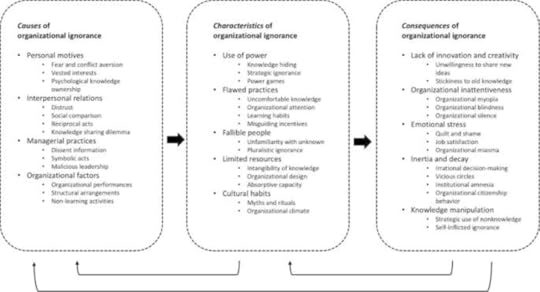 [image error]
[image error]
January 5, 2025
Rachel Teague: Profiles in Knowledge — Rising Stars Series

This is the 111th article in the Profiles in Knowledge series featuring thought leaders in knowledge management and the first in the Rising Stars Series. Rachel Teague is a KM consultant, speaker, facilitator, educator, and writer. Her primary focus is the human dimension of KM, focusing on culture, knowledge transfer, and knowledge retention. She specializes in change management, process improvement, and diversity/equity/inclusion in the realms of knowledge, education, and organizational enhancement.
I met Rachel at an SIKM KMWorld dinner, introduced by John Hovell. I wrote about her presentation at the 2023 Midwest KM Symposium. At KMWorld 2024, Rachel suggested that I start a new Rising Stars Series. I liked the idea and asked her to collaborate with me on it. Starting this year, Rachel and I will feature an up-and-coming thought leader in knowledge management as the first Profile in Knowledge of each quarter.
InterviewI posed ten questions to Rachel to kick off the series. Here are her answers.
1. What led you into the field of KM, and why are you passionate about it?Like many, I fell into KM largely by accident. I had transitioned out of a job at the university that had been eliminated and into what I now refer to as my gap year where I joined the family business on a payroll consulting project as the person responsible for documentation. My counterpart was an incredibly smart man who could read any manual and immediately use the new thing in the course of a weekend, but lacked the skills necessary to work with the people responsible for the implementing the new thing. My sweet spot was communicating and building rapport with the people through the change at hand and helping capture the tacit knowledge. I didn’t have the words or know-how at the time to recognize that what I was doing was KM. Fast forward to a year later when the project wrapped, things lined up, and I made my boomerang back to the university in a brand new role doing training and documenting for a KM team. I’ve been back at the university for 5 years now (bringing my total to 8).
I am passionate about what I do because in my world, KM isn’t just about process or systems — at the core it’s about people; to see how the dots connect so to speak, and to really take the time to understand how each decision/person/problem/perspective/idea influences the overall culture is truly a fascinating case study in and of itself.
2. What are your specialties?Many people have the misconception that KM has to be far more complex than what it actually is at its core — which is about people. My specialty in KM has become just that — my focus has been on all things people, culture, sharing, networking, and knowledge transfer. I love being able to help translate nerd to human and make KM accessible to everyone.
3. Who are your influences, and why?In the KM space, I owe much of my foundation to my friend and mentor, John Hovell. From introducing me to key people and ideas in our community, to countless hours of conversation and problem-solving, John has been an incredible guide throughout my KM and consultancy journey.
I’m also fortunate to have a small group of Women in KM who I connect with regularly — at least a few times a week. This group has become a solid support system in my life. A handful of us maintain an ongoing WhatsApp thread that helps us navigate time zones (one member lives full-time in the Middle East). Through this thread, we collaborate in real time to tackle the biggest KM challenges that cross our desks, celebrate wins, and share news. Together, we also co-facilitate a larger Women in KM group on LinkedIn. While we weren’t as active as we hoped to be in 2024, only meeting once per quarter, we have high hopes for stepping it up in 2025!
4. If you could only implement one component as part of a KM program, what would it be, and why?That’s an interesting question! I naturally gravitate toward people-focused aspects like collaboration, communities, culture and values, and training — all of which are critical components of a KM program. However, if I could only implement one thing, I’d choose having a dedicated knowledge manager.
An expert KM practitioner can effectively tie all these pieces together while advocating for the value KM brings. Acting as the System Convener (a term coined by the Wenger-Trayners), this individual can bring the right stakeholders to the table — L&D for training, senior leaders for buy-in and culture shifts, KM champions for cross-functional collaboration, and IT for the technical setup of a repository. With this leadership in place, a KM program can evolve from just an idea into a fully realized and impactful initiative.
5. What is your vision for a successful KM program?My vision for a successful KM is rooted in creating a dynamic, inclusive, and sustainable system that empowers individuals and organizations to thrive through effective knowledge sharing, retention, and innovation. I want to harness its power as a tool for transformation — one that builds bridges between people, preserves the past while preparing for the future, and ensures that knowledge becomes a force for positive, sustainable change in every context it touches.
In an ideal world a program will include:
Creating a Culture of Learning and Sharing — I envision KM as a cornerstone of organizational culture, where knowledge flows freely and intentionally across teams and hierarchies. Leadership actively supports and models a strong learning and sharing ethos, ensuring that no one operates in silos and that knowledge is treated as a shared resource rather than a personal asset.Purpose-Driven Knowledge Strategies — Clearly defined strategies that align KM efforts with organizational goals. These strategies prioritize not only the immediate needs of the organization but also long-term sustainability, adaptability, and innovation.Inclusive & Collaborative KM Systems — My vision emphasizes KM systems that are accessible, user-friendly, and inclusive. These systems respect diverse perspectives and make space for voices that are often underrepresented, particularly within marginalized communities.Empowering Others Through Knowledge Transfer — KM is more than just preserving information — it’s about enabling others to succeed by sharing knowledge in ways that are practical, actionable, and meaningful. My focus on knowledge transfer and retention reflects a commitment to helping individuals and teams navigate transitions and achieve long-term success.An Ethical & Human-Centered Approach — Grounded in my values, my KM vision promotes ethical practices. It resists the commodification of knowledge and instead treats it as a vital tool for growth, problem-solving, and connection. This also includes a focus on equity, ensuring that everyone — from employees to external collaborators — benefits from the shared knowledge ecosystem.Continuous Learning & Adaptation — KM is never static. It must adapt to evolving challenges and technologies while fostering a mindset of continuous learning — not just for individuals, but for entire organizations. KM as a living, breathing discipline that evolves as people and organizations grow.6. What are you most proud of in your career so far?I’m most proud of the unconventional path that brought me to where I am today. In all my experience, I’ve only met one person who intentionally set out to build a career in knowledge management (KM). My own journey has been anything but linear — full of twists, turns, and a foundation rooted in education and training — but it’s a path I wouldn’t trade, and I’m proud of where it’s led me. I wouldn’t call myself the most famous or “successful” person out there — though success is a whole other debate — but I’ve worked incredibly hard to get here. The past few years have been a whirlwind: finishing my doctorate, stepping fully into the KM space, teaching, launching a consulting practice with my wife, and making a point to learn something new every day. Even now, surrounded by some of the brightest minds in the field and doing work that feels meaningful, I know there’s still so much more to learn. Looking back, I’m especially proud of how my nontraditional path shaped me. It took time to find my place, but discovering KM has felt like finding the missing piece to a puzzle I’ve been working on my whole life.
7. What would you like to accomplish in the short term and long term?Goals in no general order:
Write a book on KM to make it more accessible for the average person.Continue to grow my business with my wife.Shift away from a grassroots KM movement at the university and moving toward a formalized enterprise-wide KM strategy.Help people leverage KM in their personal lives.8. What are your top three knowledge nuggets/insights/lessons learned?KM initiatives don’t need to be huge endeavors. Sometimes even the smallest changes/projects can lead to the greatest successes. I am a habitual list maker and, in my experience, as gratifying as it is to see a massive project completed, the dopamine hit can be just as satisfying to cross off a dozen small projects one at a time toward a larger goal. The list can include process documents created or updated, new people trained, important conversations scheduled and/or had and communications shared. These seemingly small or simple things can be incredibly vital to any major project or implementation, and being able to see the progress toward the goal in real time can be incredibly impactful.Anyone can participate in KM. You don’t need a fancy degree or certification to be successful in KM — you need to have an interest in sharing, a desire to learn, and willingness to apply your outcomes to your daily efforts.KM is a team sport as much as it is an individual effort.9. What led you to suggest the Rising Stars series?There are so many legends and remarkable people who have laid such a strong foundation in our field, and as with any generational cycle, there comes time for a shift. As I have attended the conference circuit in the last few years I am starting to see more and more of the next generation bringing new ideas and old ideas with new perspective/vision to the table. While we have to honor those who have come before us, it’s time to start looking at our future as well in preparing for what is to come.
10. How can others become Rising Stars featured in this series?I envision this as a nomination process. Do you know someone who has done something neat in KM? Who is contributing to the community in new ways or practicing old ideas in new ways? I’d love to talk with you. I can be reached at rachel@disruptionleaders.com.
Background EducationNorthcentral University — Doctor of Education — EdD, Global Training & Development with focus on Knowledge Management, 2022Western Governors UniversityMaster of Science, Management & Leadership, 2016–2017BA, Education, 2012–2016ExperienceDisruption Learning & Technology LLC — Co-Founder, Principal Consultant, 2023 — PresentAssociation for Talent Development (ATD) — Learning Facilitator, 2022 — PresentSouthern New Hampshire UniversitySenior Knowledge Management & Training Specialist, 2020 — PresentAdjunct Faculty Instructor, 2021 — PresentIndependent Consultant, 2018–2023Admissions & Training Specialist, 2016–2018Salter School of Nursing & Allied Health — Senior Admissions Representative, 2015–2016NH Association for Justice — Education and Membership Coordinator, 2013–2015ProfilesLinkedInATDNERCOMPFacebookContentLinkedIn PostsHow an Effective Knowledge Management Program Supports Critical Tacit Knowledge Retention Within a Higher Education Institution: A Qualitative Intrinsic Case StudyKnowledge-Management-in-Education: Often the Missing Link in Developing a Robust Learning Organization with Timothy BillbroughSave the Knowledge
EducationNorthcentral University — Doctor of Education — EdD, Global Training & Development with focus on Knowledge Management, 2022Western Governors UniversityMaster of Science, Management & Leadership, 2016–2017BA, Education, 2012–2016ExperienceDisruption Learning & Technology LLC — Co-Founder, Principal Consultant, 2023 — PresentAssociation for Talent Development (ATD) — Learning Facilitator, 2022 — PresentSouthern New Hampshire UniversitySenior Knowledge Management & Training Specialist, 2020 — PresentAdjunct Faculty Instructor, 2021 — PresentIndependent Consultant, 2018–2023Admissions & Training Specialist, 2016–2018Salter School of Nursing & Allied Health — Senior Admissions Representative, 2015–2016NH Association for Justice — Education and Membership Coordinator, 2013–2015ProfilesLinkedInATDNERCOMPFacebookContentLinkedIn PostsHow an Effective Knowledge Management Program Supports Critical Tacit Knowledge Retention Within a Higher Education Institution: A Qualitative Intrinsic Case StudyKnowledge-Management-in-Education: Often the Missing Link in Developing a Robust Learning Organization with Timothy BillbroughSave the KnowledgeWithout a knowledge management strategy, organizations risk losing vital information.
What a time to be alive and thriving as a professional in today’s talent development workforce. Workers have every opportunity in the palms of their hands to advance and grow in ways earlier generations could never have imagined. Technology has advanced, as have social and professional networks, opportunities for continuing education, learning events, historical knowledge, projects, and miscellaneous data. Organizations are full of individual people who each bring different perspectives and experiences and are essentially their own knowledge warehouses full of all kinds of data on a variety of subjects.
Now consider for a moment that in the wake of the Great Resignation, employees have the power to make moves to find the right professional fit, which also creates increased mobility within companies. There’s also the natural attrition that retirement brings. Those realities put the aforementioned knowledge warehouses at risk. Suddenly — with attrition and changes facing an employer more regularly — the impacts of knowledge moving and leaving organizations come at a cost felt far and wide with loss that is not just financial (such as the cost of hiring, onboarding, and training) but also intellectual in nature (for example, team productivity, organizational culture, tacit knowledge, and time).
What if I said that organizations can save much of that lost knowledge before it is too late? With the right tools and organizational mindset in place, knowledge retention can be relatively easy to achieve.
Having a well-defined knowledge management (KM) strategy is a proactive approach to capturing and documenting essential roles and critical information. Without such a strategy, a company risks not only the financial investment tied to recruitment but also the intangible loss of valuable insights and institutional knowledge that departing employees possess.
KM transcends mere process and technology systems; it is fundamentally about people — individuals, organizations, communities, and cultures. By implementing a robust KM strategy, a company demonstrates a commitment to preserving and leveraging the collective wisdom of its workforce.
In essence, KM is a strategic investment, ensuring that the wealth of knowledge within an organization remains intact even as individuals transition in and out.
Types of knowledge
In its standard for knowledge management (ISO-30401), the International Organization for Standardization defines knowledge as “a human or organizational asset enabling effective decisions and action in context.” With that definition in mind, there are three types of knowledge that people commonly interact with every day: tacit, implicit, and explicit.
Tacit knowledge is that which someone acquires through personal experience and is challenging to express using words, whether spoken or written. To illustrate the concept, consider the perspective of a skilled potter at their wheel. The potter can discern the condition of their clay solely through touch, instinctively knowing whether it’s suitable for their work.
Via extensive practice, the experienced potter has developed an innate understanding of what’s required to achieve their desired results, even though they may struggle to articulate it in precise terms or measurements. Nevertheless, they can try to guide others and share their expertise by demonstrating techniques. In the context of TD, an example of tacit knowledge is understanding the dynamics of the relationship between a facilitator and their participants during a training course.
Implicit knowledge is information that comes from understanding and experience, often acquired by someone being present for or engaging in an activity. A knowledge holder can usually express that type of knowledge in words, but they haven’t formally recorded or documented any of it.
Unlike tacit knowledge, which is difficult to articulate, implicit knowledge is usually much easier for knowledge holders to express. Additionally, people who work in similar fields commonly assume that others possess such knowledge, leading to a tendency to neglect the need for formal documentation. For example, the facilitator of an instructional design program may assume that a participant has a baseline understanding of how to operate the technology the class will use during the course.
Explicit knowledge is that which a knowledge holder writes down, documents, and makes especially clear through written mediums such as a process handbook or knowledge repository. Individuals easily share explicit knowledge because they understand and explain it with visual information. An example of explicit knowledge is content in an on-demand course.
In their book Working Knowledge, KM pioneers Thomas Davenport and Laurence Prusak describe KM as “a fluid mix of framed experience, values, contextual information, and expert insight that provides a framework for evaluating and incorporating new experiences and information. It originates and is applied in the minds of knowers. In organizations, it often becomes embedded not only in documents or repositories but also in organizational routines, processes, practices, and norms.”
The purpose of KM is to move from tacit knowledge, where it may sit in the knowledge holder’s head, to a place where the knowledge holder communicates it in such a way through documentation and sharing that it is easily accessible, therefore making it explicit knowledge. To save knowledge before it walks out the door, a company must identify what knowledge exists in the first place and what gaps exist with regard to documentation, process steps, and communication.
There are many ways to bank knowledge, spanning from basic succession planning done in-house, leveraging internal skills and resources, to hiring an external consultant to complete a comprehensive knowledge gap analysis.
While there is value in hiring a consultant to assist with completing a comprehensive analysis, it isn’t always necessary to go that route. Regardless of whether a company plans to make changes to embrace knowledge retention on its own or with a consultant, there are two main steps to take.
Step 1: Identify knowledge
The overarching question a company needs to ask is: Does our organization document knowledge? To get a complete picture of how knowledge exists within the organization, it must collect data from every department. Ideally, each department will identify one or two representatives to share the state of their team’s knowledge. Depending on the company size and logistical constraints, the organization can collect the information via a semi-structured interview or a survey.
Laying the groundwork for an effective knowledge gap analysis, whether simple or complex in nature, begins by determining what knowledge currently exists. It could be in the form of physical or electronic documents such as job aids, frequently asked questions, how-to guides, handbooks, process documents, or department-specific onboarding and offboarding practices; visual content via videos; or even undocumented information residing in the minds of tenured staff. Don’t be afraid to ask for a sample of any physical document.
Next, identify where knowledge lives. For instance, it could be in the learning management system, a centralized repository, a dedicated universal or team-specific knowledge base, SharePoint, or a wiki.
In addition, determine how freely knowledge flows from place to place. Is knowledge well documented and easy for staff to access and find, or is it siloed or stuck in different internal locations? Does the organization have a culture that embraces knowledge sharing? Further, how does knowledge exist within its domain as it relates to its life cycle? For instance, what is the cadence for revisions, retirement, and updates?
Examine the information gathered and consider the where and how.
Do people know where to find knowledge and, even more important, has someone documented the knowledge?Is knowledge stored in the same place? Different places? Are there similarities worth noting?Is there a master repository, and do people trust the knowledge?Across departments:
Does knowledge look the same? Are similar templates or structures in place?Does knowledge sound the same? Is the taxonomy similar?Are people sharing knowledge?Consider the story the data is telling. There is often more than enough knowledge in an organization to keep it running. But as a company experiences attrition and circumstances pivot and change on a moment’s notice (such as during a pandemic, which can change the concept of work overnight), tacit knowledge can only remain sustainable and viable for so long. Therefore, companies must ensure that employees are transitioning tacit knowledge into explicit knowledge in a place where the workforce can easily retrieve it.
Step 2: Build a bridge
Building a bridge from tacit to explicit knowledge requires having the right tools.
Foster a knowledge-sharing culture. Organizations must set the expectation from the beginning that knowledge sharing is for everyone, from the CEO to custodial staff. It is imperative to make cross-departmental collaboration and communication the norm on a company-wide scale.
Many businesses have defined value statements or brand behaviors that leaders often reference and sometimes celebrate at all-staff meetings and in internal staff communications. Organizations should use those opportunities to capitalize on knowledge sharing. For some companies, such a culture shift may seem radical, but to make forward momentum, it is necessary to prioritize. Remember that planting small seeds can grow a beautiful, bountiful harvest.
Incorporate KM tools in daily operations, one at a time. Knowledge transfer and retention don’t have to be a giant, overwhelming process every time. In fact, starting small and documenting a little bit of information at a time on a standardized template can add up. Over time, teams and the company will build a new repository full of clean, accurate information that is easy for staff to find and access.
In addition to standard templates, other KM tools to incorporate into daily operations that will encourage knowledge sharing and retention are lunch & learns, formal process captures resulting in official documentation for updating roles and responsibilities among a team, all-staff meetings, and visual process flow charts.
Treat people as the greatest asset. One of the best ways for a company to make its employees feel valued is by treating them well and promoting learning at all levels, regardless of job title. When an organization creates an environment that encourages continuous learning and invests in employee success, staff will more likely feel valued and motivated to contribute their talents in return. They will freely share information and learn from each other. Social learning is just as valuable as formal learning, especially in the workplace, because it is where a lot of knowledge sharing and retention happens.
When team members feel comfortable and supported in their roles and environment, they are more likely to embrace changes within the company. That creates a smooth transition and boosts overall organizational morale.
In a world of constant change, saving valuable knowledge is a company’s secret weapon. By making knowledge sharing a way of life, promoting ongoing learning, and integrating KM tools into daily operations, employers can secure a brighter future. Ensure that knowledge stays where it belongs.
Assembling a Knowledge Governance Committee
Companies should form a committee comprising individuals across the organization to manage a knowledge gap analysis. Identifying one or two people from each department or major team ensures that every team has a voice. In analyzing the collected data, committee members must look for areas of clear similarities, differences, and crossover regarding knowledge — for example, in terms of process, procedure, taxonomy, repository, templates, culture, and norms.
After the committee articulates and presents its findings to stakeholders, it will then shift to serving in the capacity of a knowledge governance committee designed to advise and determine best practices for the organization to follow regarding anything related to knowledge management.
SIKM Leaders CommunityPostsNew Year, New Personal KM Tools?
I’ve always had the good fortune of being super organized in managing the chaos of my day job/clients/family very well by my use of lists, calendars and even designated repositories for personal knowledge management. I’ve dabbled with tools like Rocket Book, TeamUp Calendars, many of the MS and Google tools, MindMap and most recently dipped my toe in with Asana for a Board I’m on (frankly I’m not sold there yet).
With all of those in mind I am curious- are there any tools or resources you’ve found helpful or that you can’t live without that make your life easier? Conversely, are there any you can’t stand that you’d steer me away from?
Old habits die hard for me and even with access to many tools, I still fall back on my paper lists. I’d love to (maybe) turn a new page for the new year.
Articles by Others9th Annual Midwest KM Symposium: Part 6: Rachel Teague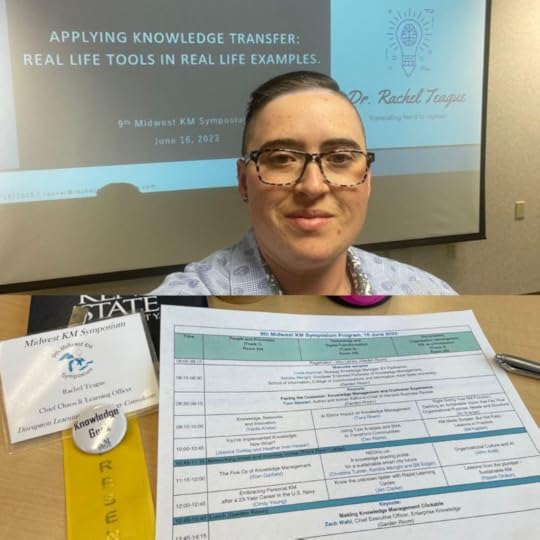 Turnover troubles: How to save institutional knowledge when your employee leaves by Paige Gross
Turnover troubles: How to save institutional knowledge when your employee leaves by Paige Gross ConferencesAPQC 2024 — Looking at KM Through Systems & Human Lenses: Can One Exist Without the Other?
ConferencesAPQC 2024 — Looking at KM Through Systems & Human Lenses: Can One Exist Without the Other?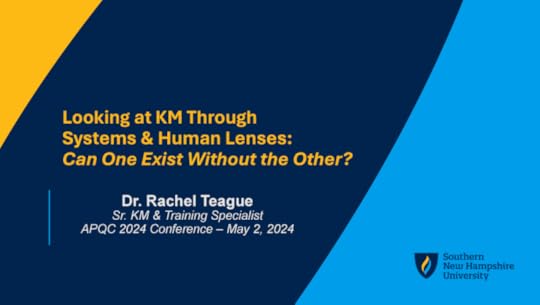 KMWorld 2024 — A303: KM Through Systems & Human Lenses — Slides
KMWorld 2024 — A303: KM Through Systems & Human Lenses — Slides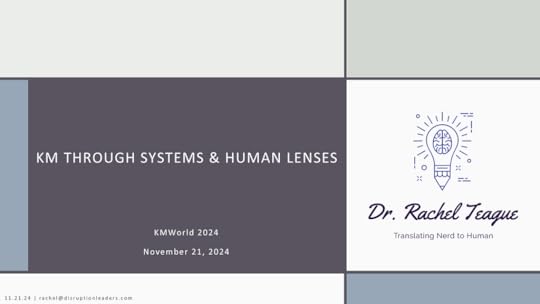 2023 Midwest KM Symposium — Applying Knowledge Transfer: Real Life Tools in Real Life Examples
2023 Midwest KM Symposium — Applying Knowledge Transfer: Real Life Tools in Real Life Examples 2023 Volunteer NH: Keynote: The Greatest Lessons I’ve Learned Come From Volunteering
2023 Volunteer NH: Keynote: The Greatest Lessons I’ve Learned Come From VolunteeringIn her professional and personal life, Dr. Rachel Teague has been known to wear a lot of “hats.” She’s a system convener, writer, Knowledge Transfer & Retention Expert, wife & mom, collaborator, volunteer, an adjunct instructor — and even an award-winning amateur cook! With such a breadth of roles, each with a variety of responsibilities and skill requirements, it can be easy to wonder where she learned the skills to do it all. For Rachel, there is one answer: volunteering.
Hear from Rachel as she relates how her past experience volunteering — in her community as a youth, as an AmeriCorps member, and even in places like the NH State Prison for Women — have been integral in shaping her foundational values and her career path. As the world emerges from COVID, Rachel will demonstrate how robust volunteerism programs can affect everyone’s lives for the better and how nonprofits can take advantage of this time of transition to learn from past experiences, to innovate, and to inspire their communities.
PodcastsBecause You Need to Know: Getting the People to People Wellhttps://medium.com/media/d7739940ddc82b6a465e2c2ee421f17d/hrefOthman’s Leadership Podcast: Knowledge Management & Change Managementhttps://medium.com/media/2c64abc26191efc3a09c1a42285f17b7/hrefVideosTEDx — Feeling stuck? Here’s the solution.https://medium.com/media/bae07b19033964b7d939f9d2ae57e84c/hrefWhat is Knowledge Managementhttps://medium.com/media/2abde6ec5eb494fd965ab4c353b2541a/hrefHow Does AI Impact Knowledge Transfer? with John Hovellhttps://medium.com/media/480b9aa7c3c5378148962f7287be5c52/hrefBookKnowledge Management and Research Innovation in Global Higher Education Institutions — Chapter 14: Infusing KM in Global Higher Education: How Effective KM Program Supports Critical Tacit Knowledge Retention Within a US Higher Education Institution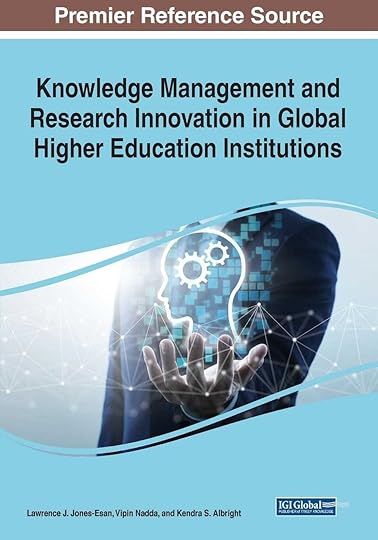 [image error]
[image error]
January 3, 2025
KM and Curiosity: Is Asking Questions the Key to Limitless Knowledge?

My editor at Lucidea, Sarah Nichols, recently suggested the topic of this post. She wrote:
I recently watched the PBS documentary by Ken Burns on Leonardo da Vinci. One of his biographers, Charles Nicholl, remarked, “It’s not just that Leonardo knew an awful lot, it’s that he found out an awful lot. The way he found out was by asking questions. Why is that happening? How does it happen? What is the quality of that thing, or person, or emotion? He’s posing questions and looking for answers.” I wonder if this statement is a thought-starter for a post?
Indeed it was!
Ten Thoughts on QuestioningI found many quotes from prominent thinkers on the value of asking questions, including:
A prudent question is one-half of wisdom. — Francis BaconGood questions outrank easy answers. — Paul SamuelsonThe art and science of asking questions is the source of all knowledge. — Thomas BergerOne who never asks either knows everything or nothing. — Malcolm ForbesThe master key of knowledge is, indeed, a persistent and frequent questioning. — Peter AbelardNever be too big to ask questions, never know too much to learn something new. — Og MandinoThe people who don’t ask questions remain clueless throughout their lives. — Neil deGrasse TysonThe wise man doesn’t give the right answers, he poses the right questions. — Claude Levi-StraussAsking the right questions takes as much skill as giving the right answers. — Robert HalfI don’t pretend we have all the answers. But the questions are certainly worth thinking about. — Arthur ClarkeChildren are great at asking questions, including endless rounds of “why?” However, as we get older, we get worse at doing this. An example is the reluctance, particularly among men, to stop and ask for directions when lost.
There is also a widespread aversion to asking questions in public forums. In my article Why won’t people ask questions in the open? I identified five reasons for this:
I’m embarrassed.I don’t want to appear ignorant.I should know the answer.No one else needs to know that I had to ask.I don’t want to bother figuring out what to do.I countered those with three benefits of asking openly:
It will allow a wide range of answers offered by a variety of respondents, including those previously unknown to the person asking the question.It will allow others to benefit from seeing the question and the answers.It will provide a public record, which can later be searched for, linked to, and reused.Ten Benefits of AskingAsking questions has many benefits. The first five fit into the SIRCL acronym for the benefits of starting a KM program. Asking questions achieves the following:
Suggests Sharing by prompting others to share what they knowInitiates Innovation by getting people thinking of possibilitiesResults in Reuse when the answers are appliedCatalyzes Collaboration by connecting those asking and answeringLeads to Learning as a result of thinking up the questions and pondering the answersGets answersFinds resources and helpSolves problemsExploits expertise and experience of othersSaves time that would have been spent searching or doing things the hard way or the wrong wayTen Ways to Use Questions and AnswersEliciting knowledge: Get knowledge flowing through a series of structured queries. This can be captured for reuse, but it is also valuable in connecting people for future knowledge flow.Pushing action: Follow up repeatedly until the desired action is taken. A recent example is when I asked a friend when he was going to resume blogging after a long hiatus, and he said that my asking might get him to do so.Engaging people: Instead of subjecting a team to a long, boring presentation, have the team prepare questions for the would-be presenter and convert the session into an interactive one. Instead of sitting back and multitasking while the presenter drones on, they will have to be on their toes and participate, and the two-way exchange might be more valuable than the one-way presentation.,Nudging communities : As a community leader, when I see that a question has not received any replies, I reply to it and ask if anyone can respond. This always works, although sometimes I have to nudge more than once.Anticipating questions: If the same questions are asked repeatedly, post the answers in a FAQ list, and the next time, just point to the answer in the list. For meetings, to prevent the inevitable question, “Will the slides be made available,” distribute them in advance.Starting discussions: Ask questions to stimulate discussions in meetings, conferences, Knowledge Cafés, and online.Breaking the ice: Use conversation starter questions to help people get to know each other. This can be done at meetings, both virtual and in-person, and in online discussions. For meetings and conferences with meals, assign people to sit with those they don’t already know well. On each table, place a bowl with slips of paper containing questions that everyone at the table should take turns answering. These should include both fun topics and deeper ones. Managing change : Instead of telling people what is going to change, ask them questions about what changes they would most like to see. Then implement as many of those changes as possible. Surveying users : Use surveys to ask questions to identify current challenges and needs, compile a list of resources and their usefulness, and solicit feedback and suggestions. Then take action based on the results.Getting satisfaction: Ask for a refund, discount, replacement, or remedial service. You never know what is possible to receive unless you ask. A recent example is when I asked Amazon if I could return a product that was past the deadline for returns. I was granted an exception, and I was able to get a full refund.Two Suggestions for Eliciting Questions (and One Exception to the Rule)1. KickstartingTo get people to ask questions, set an example. In meetings or conferences, ask the first question, and others will likely follow your lead. In online discussions, prime the pump by asking questions and privately asking a few other respected community members to do the same. Take steps to ensure that all questions receive timely and helpful answers so that others will take note and be more likely to ask their own.
2. DirectingIf you send a question to a large distribution list, pose it to a large group in a meeting, or post it to a community, it may not receive any answers. People will assume that someone else will answer it, or they may be afraid of answering in the open for fear of being wrong. You may need to send the question privately and separately to one or more people who are likely to be able to supply answers. Upon receiving your private message, they will take it more seriously and will not be concerned that others will see their reply. If the answers you receive are valuable, you can post them back into the community, either anonymously or using the name of the responder if they agree.
An Exception to the RuleIn the early days of online communities, there was an expectation that you would search the discussion archives first before asking a question. If you failed to do so and posted a question that was previously answered, you might be admonished to search first.
In general, I don’t think people asking questions should be discouraged from doing so; it’s hard enough to get people to post, so slapping them on the wrist is a bad idea.
The exception is when people ask questions they could have answered for themselves with just a tiny bit of effort. Doing so would have spared others from having to endure an onslaught of redundant and trivial replies. An example is asking if a platform like Facebook or Instagram is down. This can be quickly checked by going to another platform, e.g., X (formerly Twitter).
Insights from ExpertsDoes Your Organization Have an Asking Problem? by Nancy DixonKnowledge sharing begins with a request, not with a solution. No matter how much knowledge is presented at conferences, held in databases, or emailed to colleagues, knowledge won’t be reused unless a team has a need — something they are struggling with.
Managers sometimes tell me that people in their organization have a problem with sharing knowledge; but more often than not, people aren’t “asking.” The organization has an asking problem, not a sharing problem. When people ask, the sharing problem becomes moot.
How organizations talk about “asking” is critical. When company officials say to professionals, “Don’t be afraid to ask for help,” their words actually work against asking. Asking for “help” denotes helplessness. No competent professional wants that image attached to his or her performance. What professionals do need is to be able to tap into organizational knowledge that is growing and changing — to tap into what others are learning from their ongoing experience. I have labeled this step “scanning,” which connotes an active seeking for something of value.
To Get People Talking, Try Asking the Right Questions by Nancy Settle-Murphy“What are your views?” versus “What’s the one aspect of this change you’re most excited about and one aspect you’re most concerned about?” If people meet your question with silence, own responsibility for the possible confusion, then pause and rephrase it: “Judging from the silence, I think that the way I worded that question may have been unclear.” Pause. “Let me phrase it another way….” Chances are, someone will chime in.
Ask questions that energize and excite people. Compare “What steps should we take to achieve our goals?” to “A genie has suddenly appeared and promised to grant you three wishes. What are your three wishes, and why?” Yes, this means you need to script questions in advance. Prepare more questions than you think you need, in case one or two fall flat. Open-ended questions usually have the potential to be more engaging than close-ended questions.
Design questions that will make it especially inviting for even the quietest people to participate. For example, instead of commenting how quiet Anna has been, try latching onto something unique about her experience that she will likely want to share, given the chance. Example: “Anna, can you compare and contrast your experiences when working in China with Jim’s? I remember how tough things were there for a while until you got the hang of it.”
Appreciative InquiryAppreciative inquiry is asking questions that strengthen a system’s capacity to apprehend, anticipate, and heighten positive potential — mobilization of inquiry through the crafting of the “unconditional positive question.”
Appreciative Inquiry is an incredibly useful tool for strategic planning, change management, and resolving challenges. It is also applicable as a good coaching practice. Leaders who use probing questions in an appreciative mode that generates collaborative learning will see long-lasting behavior changes.
Examples of Productive Questions in Typical SettingsVirtual MeetingPeople are reluctant to answer general questions in a group setting. To break the ice, ask questions that everyone can answer without the fear of being wrong.
What elementary school did you attend?What is the last book you read?What music are you enjoying lately?What sports teams do you support?What was the best meal you have had recently?Community PresentationFew are motivated to speak up if you ask, “Are there any questions?” during a presentation. Instead, ask specific questions of the audience.
Has anyone experienced what the presenter just described?What would be required for you to reuse these ideas?What are some related techniques our community members are using?After Action ReviewWhat went well?What did not go well?What would you do differently?PodcastWhat led you into this field?Why are you passionate about it?What are your specialties?Who are your influences, and why?If you were not in this field, what would you be doing instead?If you could only implement one thing, what would it be, and why?What is your vision for success?What are you most proud of in your career so far?What would you like to accomplish in the short term and long term?What are your top three knowledge nuggets/insights/lessons learned?Leadership Self-ExaminationHow did I lead by example, and how will I continue doing so?What bold actions did I take, and which ones do I need to take next?What tough decisions did I make, and which ones do I need to make next?Whom did I help, how did I help them, and whom should I help next?What did I communicate, how did I do it, how was it received, and how do I plan to communicate next?Whose ideas did I seek, how did I use those ideas, and how will I seek more ideas?What did I learn, how will I apply it, and what do I want to learn next?To whom did I delegate, what did I ask them to do, and to whom should I delegate more?What commitments did I make, which ones did I meet, and which ones do I still need to meet?Whom did I praise, and whom should I thank next?InterviewWhat did you want to be when you went to college?What was your first job after college? Why did you make this choice?How did you get into your current field?What would you do if you weren’t doing your current job?Do your family and friends understand what you do for a living? Do you even bother to explain?What did your parents do for a living? What impact did that have on your choice of career?Can you share a situation that has occurred in your life that you feel provides insight as to your character?Who are your personal heroes? Why do you hold them in such high regard?What is a passion of yours that you rarely share with people at work? Why not?What was a turning point in your life? How did it affect you?[image error]December 20, 2024
Knowledge Management Thought Leader 94: Nick Milton

Nick Milton is a consultant, author, speaker, and instructor. He is Director and VP of Knowledge Management consulting and training at Knoco Ltd. and was a Knowledge Manager at BP. He was a member of the working group ISO/TC 260/WG6 for the development of the ISO standard for Knowledge Management (ISO standard 30401).
Nick consults on knowledge management strategy, KM framework development, and knowledge management implementation. He specializes in lessons learned, capturing and synthesizing knowledge, and managing major knowledge capture programs for big projects.
Here are definitions for five of Nick’s specialties:
1. ISO 30401: A standard for knowledge management systems that sets requirements and provides guidelines for establishing, implementing, maintaining, reviewing, and improving an effective management system for knowledge management in organizations.
2. Knowledge Capture: Collecting documents, presentations, spreadsheets, records, processes, software source, images, audio, video, and other files that can be used for innovation, reuse, and learning.
3. Knowledge Synthesis: Summarizing existing documents to create new content. More than curating documents, it is combining them, removing duplication and contradiction, and updating the content. The resulting document is organized, well-structured, and validated by an expert or a community of practice.
4. Lessons Learned: Explaining what an individual or team has learned as a result of their experience, using documents, presentations, discussions, and recordings. This includes capturing what was tried, what worked, what didn’t work, what to do, what to avoid, problems faced, how problems were solved, what to do differently next time, and key insights and nuggets.
5. Strategy: A set of guiding principles that, when communicated and adopted in the organization, generates a desired pattern of decision making. The way that people throughout the organization should make decisions and allocate resources in order accomplish key objectives. A strategy provides a clear roadmap that defines the actions people should take (and not take) and the things they should prioritize (and not prioritize) to achieve desired goals.

For more about Nick, see Profiles in Knowledge. Nick created the following content. I have curated it to represent his contributions to the field.
Books by Nick Milton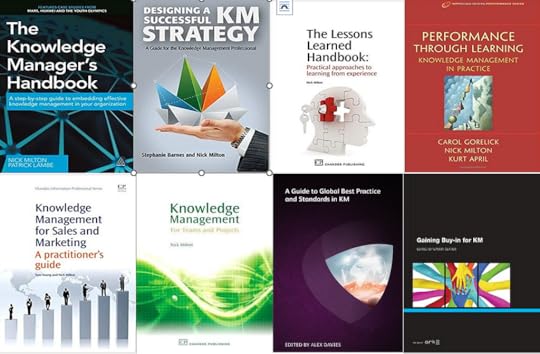 The Four Business Focus Areas for Knowledge Management
The Four Business Focus Areas for Knowledge Management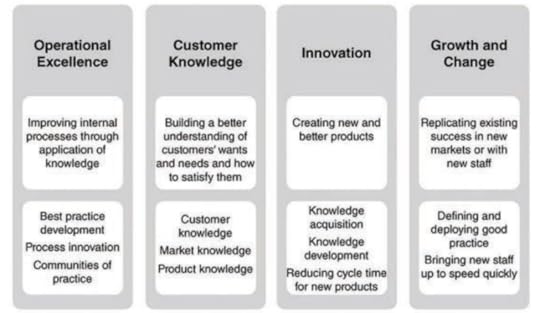 The three levels of lesson-learning — don’t get stuck at level 1!
The three levels of lesson-learning — don’t get stuck at level 1!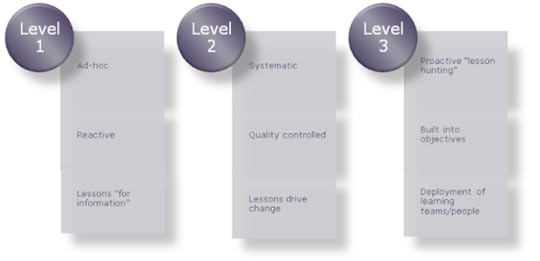 The top 7 tips for successful knowledge management programsKM needs to be driven by operational needs.KM needs to be introduced as a management framework.KM needs to address Pull as well as Push and demand as well as supply.KM is a culture change process.KM must be embedded in the business.KM needs not just high level support, but high level expectation.KM should be introduced first where the highest value decisions are made.[image error]
The top 7 tips for successful knowledge management programsKM needs to be driven by operational needs.KM needs to be introduced as a management framework.KM needs to address Pull as well as Push and demand as well as supply.KM is a culture change process.KM must be embedded in the business.KM needs not just high level support, but high level expectation.KM should be introduced first where the highest value decisions are made.[image error]
December 13, 2024
16 Suggestions from a Pragmatic KM Curmudgeon

The late Melissie Rumizen wrote, “I’d like to play the role of Knowledge Curmudgeon, as long as I get to define curmudgeon as someone who is stubbornly and determinedly grounded in the practical.” Similarly, KM researcher Dave Snowden is a self-described “proud curmudgeon and pragmatic cynic.”
In this article, I take on the role of pragmatic curmudgeon. I would like to share sixteen suggestions for improved communication, collaboration, and choices.
Each of my suggestions begins with a critique of common practices I see online and ends with a pragmatic suggestion for better communication. Some of these may seem controversial, but I believe following this advice will result in increased clarity, focus, and collaboration.
1. Trite and TrueMany online comments fall under the category of the banal, for example:
So true!Congrats!Well deserved!Awesome!That’s amazing!Most of the time, these comments can be replaced by just clicking the Like button. In particular, avoid sequences of comments such as:
Cain: Congratulations, Abel!Abel: Thanks, Cain!Cain: You’re welcome, Abel!Abel: Don’t mention it, Cain!Of course, that is intentional exaggeration to make the point that such comments are just wasting everyone’s time and attention.
Suggestion: Hit the Like button on posts to agree with or thank the person instead of posting trite comments.
2. Humble BraggingOften what people post online contains a bit of boasting, for example:
I am happy to share…Pleased to announce…Excited that…Thrilled to have…I am humbled by…If you post about an achievement, try to include something that may be of value to the reader. For example, “I am grateful to have been given the opportunity to speak at KMWorld. Here is a link to my slides.”
Incidentally, “humbled” means “to make someone understand that they are not as important or special as they thought.” It is now common to hear people use this word when they mean “grateful,” as in “I am humbled to receive this award.” This is the opposite of the actual meaning, so it is better to say, “I am very grateful to receive this award.” Alternatively, you can use the word correctly by saying, “I was humbled to learn that my submission was not accepted.”
Suggestion: Include useful content when announcing something of which you are proud.
3. Six Degrees of Self-PromotionSome people include a set of initials in their titles, for example:
CCA, PI, QTE, CISMMKM, CKM, CKSLIS, CKM, CKS, CLCKM, KCS, MSCCXP, CPWhile it is nice to be proud of your degrees and certifications, having them appear whenever your name is mentioned on LinkedIn can appear a bit excessive. Moreover, some certifications are of questionable value, so brandishing them may have the opposite effect of what is intended.
Suggestion: Just use your name in your LinkedIn profile and leave out a string of credentials. Let your content speak for itself.
4. Reduce Recycled RhetoricHave you ever heard any of these?
Knowledge management is all about the people.Technology is merely an enabler.Data can be organized into information that can become knowledge, which can be distilled into wisdom.Increasing employee engagement is critical.Knowledge is power.Many articles and posts consist mostly of recycled, tired, and predictable content. Instead of trotting out the same old bromides, try to offer new insights or tell stories about what you learned based on personal experience.
Suggestion: Before posting, ask yourself if what you are about to say is in any way new or insightful. If not, don’t post.
5. Short But Not SweetMuch of what I read online consists of short posts rather than thoughtful articles. It is hard to write in-depth articles and publish book chapters or full books. Nevertheless, the extra effort is worth it.
Suggestion: Devote more time to researching topics and thoroughly expanding your thinking before posting.
6. TL;DRThis expression stands for “Too long; didn’t read.” Although it takes time to read complete articles and books, listen carefully to entire presentations and podcasts, and pay attention during webinars and conferences, it is the only way to grasp what is being communicated so that it becomes actual learning and understanding. Short attention spans, multitasking, and skimming result in missing a lot of important information.
On LinkedIn posts that contain links to full articles I have written, I have seen many likes and comments made over the years. I doubt that most of the people doing the liking and commenting have actually read the full articles. For example, my KM infographics always contain a link to the source post from which the image was derived. Rather than clicking through and reading that full article, some will post comments that ignore that content. They are commenting based on just the bullets in the infographic. On articles, some are commenting based on just the headline. I would like to propose a new meaning for TL;DR — To learn, definitely read.
Suggestion: Before commenting on a post, take the time to read the full content to which it links.
7. No-ShowsThe SIKM Leaders Community has held over 230 monthly calls since forming in 2005. It has grown from the initial eight to over 1,240 members. Every member is a KM practitioner, or a professional interested enough in KM to join the community. Yet the typical number of attendees on the monthly calls is 20. I often wonder what the other 1,220 members are doing during that hour. Is it so important that they are unable or unwilling to spend 60 minutes learning from a thought leader and from their fellow members?
Years later, will you even remember what you did during that hour? You could have benefited from free presentations by Zach Wahl, John Hovell, Jane McConnell, Heather Hedden, Madanmohan Rao, Stephanie Barnes, Harold Jarche, Alex Bennet, Nancy Dixon, Art Murray, Moria Levy, Seth Earley, Gloria Burke, Patrick Lambe, and many other KM thought leaders. But you chose to do what, instead?
What about attending a webinar, conference, local KM community meeting, or training event? Too busy? Think about what is more important and make a different decision.
Suggestion: Make time to attend events where you can learn something useful. Then pay attention during the event.
8. Silence of the LambsDuring the monthly SIKM calls, there is always a chance to ask questions and engage the presenters in discussion. Of the roughly 20 people who attend, only a few will ever take advantage of this opportunity. This is expected behavior, as I wrote about in The Sound of Silence. It is still a shame that more KM professionals don’t choose to model the behaviors that they would like their KM users to demonstrate.
Suggestion: When attending events, speak up when offered the chance to ask questions or make comments.
9. Herd MentalityPeople tend to follow the crowd and go along with what others are saying, what media channels are featuring, and what vendors are promoting. It is important to apply critical thinking and formulate your own ideas based on a combination of the writing of others you respect, and your own independent analysis.
Just because everyone else is jumping on the bandwagon of the latest trend, you don’t have to. Seeing many others present the DIKW pyramid, use maturity models, or try to compute the ROI of KM does not mean you should follow their lead.
Suggestion: Think for yourself, reject fads, and do not worry about being judged.
10. You’ve Got MailDespite the fact that online threaded discussions have been available for over 40 years, many people — including KMers who should know better — continue to converse via email. If as a profession we cannot do any better, how can we expect our users to participate effectively in communities?
We should lead by example and conduct discussions in communities, enterprise social networks, and other appropriate collaboration tools. Use email only for that which it is best suited: one-to-one, one-to-few, one-to-many, or few-to-few private communications — not many-to-many or public communications.
Suggestion: Use threaded discussion tools for multi-person discussions, not email.
11. The Right Tool for the JobBeyond email, other tools are frequently used in ways for which they are not the ideal choice. For example, social media tools such as LinkedIn, chat tools such as Slack, and various Microsoft tools such as Teams, none of which are optimal for communities, are often pressed into use for that purpose.
LinkedIn posts and Groups, Slack channels, and Microsoft Teams can be used for commenting and conversing but are not ideal for community threaded discussions. In the Microsoft environment, Viva Engage (formerly Yammer) is much better suited for this purpose than Teams.
In the Lucidea environment, KM platform Presto provides Social Knowledge Networks that allow users to engage with content and add value by liking, tagging, rating, or commenting. For external communities, Groups.io provides excellent threaded discussion functionality.
Suggestions: To enable scaling up to a large number of members, preserving conversations in easily found threads, and better integrating with email and other tools, implement the optimal collaboration tool. Instead of discussing knowledge management in LinkedIn, join the SIKM Leaders Community and post there.
12. Penny Wise, Pound FoolishThe publisher priced my book, Handbook of Community Management: A Guide to Leading Communities of Practice, higher than I wanted. That should not prevent those who need to start a communities program from buying it and applying its principles and techniques. Nevertheless, I have heard from multiple potential buyers that it is too expensive. When I point out to them that the book draws from my multiple decades of experience in leading communities and that to engage me as consultant to provide that expertise would be much costlier, they scoff.
Worrying only about price, not potential value, is a mistake. What is the cost of a struggling or failing KM program? A lot more than the cost of one book. Similarly, the benefits of attending a conference, participating in training, hiring an experienced consultant, or licensing software to meet a specific need should outweigh the costs. Assuredly, you need to choose the right conferences, training, consultants, and software, but with proper due diligence, the investments should pay off and the minimal expenses soon forgotten.
Suggestion: Do not worry about whether the price of something seems “too high.” Spend money when doing so will result in significant benefits.
13. Breaking BadIn curating content for my KM site and for my writing, I frequently encounter sites with missing content, “coming soon” or “under construction” signs, broken links, bad or obsolete content, ineffective search, poor usability, and other sins of commission and omission.
Here are a few rules to follow for offering better websites:
Regularly check your site to ensure that all promised content is available.Add new content right after it has been created.Regularly test all links to ensure that they still work. Fix the ones that don’t, using the Wayback Machine as necessary to restore links to external content that was previously available but is no longer online.Never use “coming soon” or “under construction” on a site. Start small and grow but deliver only what is currently available and add more as it becomes available.Update or remove bad or obsolete content. However, do not delete content just because it is old. If the content is still of possible use and using it will not result in any problems, leave it in place.Avoid reorganizing your site in such a way that links that once worked will no longer work. If you must change URLs, ensure that all the old ones successfully redirect to the new ones to prevent broken links.Make site search work as well or better than a Google search aimed at your site would do.Suggestion: Hire a usability consultant to review your site or learn about user experience and apply proven practices to your site.
14. Defining MomentsSome KMers love to debate definitions and other esoterica. I don’t spend time on that. For example, I have seen many protracted discussions on:
Defining knowledgeDefining the kinds of knowledge, e.g., tacit and explicitDefining KMThe current state of KMThe future of KMHow KM relates to other professions, e.g., Learning & Development and Organization DevelopmentThe latest trends in KMI fail to see the value of these endless debates. I would rather talk about practical matters.
Suggestion: Ask questions and start discussions about what works; what doesn’t work; how to accomplish specific tasks; what technology can do for KM; lessons learned, proven practices; success stories, and how to solve problems.
15. Naïve NotionsMany initiatives start with the best of intentions but lack a sober view of reality. Examples include:
An initiative on KM education with many committees, none of which took off or led anywhereAn attempt to collect and unify all KM knowledge in a single placeEfforts to create a single global KM communityA program to promote tacit knowledge management as a new worldwide discipline, with ambitious goals for an extensive organization and high-level influence in government and businessAttempts to come up with new names, definitions, and directions for KMWhile I am in favor of attempts to reduce redundancy and unnecessary overlaps, it is unrealistic to assume that most of the initiatives listed above will achieve most (or any) of their stated goals. I endorse collaboration, cooperation, and integration wherever possible. However, I oppose efforts that fail to understand why past ones in the same vein failed, and especially ones that are trying to reinvent the wheel or replicate organizations and communities that already exist.
Suggestion: Before starting a new initiative, research the history of similar efforts. Spend time and energy on projects that have a reasonable chance of success.
16. One Step Forward, Two Steps BackI am wary of so-called improvements in websites, software, and organizations. We have all seen promises such as:
Introducing our newly improved site!The new version of our software will create a much better user experience.This reorganization/merger/acquisition will result in greater efficiency based on synergies yielding greater stakeholder value.The reality is often quite different:
The new site eliminated functionality, removed content that was useful, and is harder to use.The new version of the software deprecated useful features, required more resources, forced a time-consuming migration, is slower, resulted in crashes, no longer works the same, etc.The new organization functions much worse than the old one, many valuable employees have left, the new management team does not understand the organization, processes are broken, etc.Suggestion: When making changes, ensure that those affected by them participate in the planning and implementation and have a voice in remedying anything that ends up worse than before.
See also Knowledge Management Sins, Pitfalls, Mistakes, and Causes of Failure.
[image error]December 11, 2024
Jon Husband: Profiles in Knowledge

This is the 110th article in the Profiles in Knowledge series featuring thought leaders in knowledge management. Jon Husband is a coach, consultant, speaker, and writer who coined and defined the term and concept of wirearchy. He is interested in the deep sociological and psychological changes introduced by the networked era, and how those become interwoven with the ways humans live and work.
Prior to becoming independent, Jon worked for 25 years in the areas of organizational effectiveness, organizational design, and organizational change with a grounding in finance, financial management, and the social sciences: psychology, sociology and economics. He learned and practiced approaches to people co-creating vision, values, objectives, and the ways to see, understand, and touch tangible results — processes like Open Space, Future Search, Improv, Participative Work Design, Appreciative Inquiry, and Scenario Planning. Jon worked at understanding the structure and the social dynamics engendered by the Web. He focuses on the sociology of human social systems and the structures and dynamics of networked organizations.
I met Jon in 2006, and we hit it off immediately. He later sent me a wirearchy t-shirt (similar to the one he is wearing in the photo below).
Background EducationGlendon Campus of York University | Campus Glendon de l’Université York — Honors BA, Sociology & Psychology, 1971–1975ExperienceWirearchy — Founder and Principal, 1998 — PresentStoryGarden — Partner, 2008–2010Work Design Associates — Principal, 1995–2000Hay Management Consultants — Senior Principal, 1986–1994ProfilesWirearchyLinkedInFacebookCultivating FlowsThe hi:project — A new chapter of the internet’s impact on human societyContentWirearchyLinkedIn PostsNetworks and Wirearchy with Valdis KrebsBlogsFrom CoLLection to CoNNection — Yves Noble of Capgemini on CG’s move to KM 2.0The FASTForward Blog: Enterprise 2.0For All Those Who Have Said Blogging Was Just a FadLinkedIn ArticlesWirearchyOn Process, Technology and Work DesignPerformance Management in an Enterprise 2.0 ContextKnowledge, Trust, Credibility and a Focus on Results — Are They Factors That Disrupt or Help Society Evolve?KM and Friendships — Blogging, Listservs, Forums, Moderation, etc.Competency Models — HR & Understanding Work in the Network EraHierarchy and Wirearchy: Hubert St. OngePerspective on Designing and Managing Knowledge Work: Inside Knowledge Masterclass, Part IPerspective on Designing and Managing Knowledge Work: Inside Knowledge Masterclass, Part IIWirearchy 1: The Intersection of People, Information and New Forms of Technology Changes Everything (Eventually) | P2P FoundationWirearchy 2: Knowledge, Trust, Credibility and a Focus on Results — Are They Factors That Disrupt or Help Society Evolve? | P2P FoundationWirearchy 3: Knowledge, power, and an historic shift in work and organizational design | P2P FoundationWirearchy 4: Co-Creating as Disruption to the Dominant Cultural Framework | P2P FoundationWirearchy 5: Hacking as Purposeful Organizational Change | P2P FoundationWhat Is Wirearchy?
EducationGlendon Campus of York University | Campus Glendon de l’Université York — Honors BA, Sociology & Psychology, 1971–1975ExperienceWirearchy — Founder and Principal, 1998 — PresentStoryGarden — Partner, 2008–2010Work Design Associates — Principal, 1995–2000Hay Management Consultants — Senior Principal, 1986–1994ProfilesWirearchyLinkedInFacebookCultivating FlowsThe hi:project — A new chapter of the internet’s impact on human societyContentWirearchyLinkedIn PostsNetworks and Wirearchy with Valdis KrebsBlogsFrom CoLLection to CoNNection — Yves Noble of Capgemini on CG’s move to KM 2.0The FASTForward Blog: Enterprise 2.0For All Those Who Have Said Blogging Was Just a FadLinkedIn ArticlesWirearchyOn Process, Technology and Work DesignPerformance Management in an Enterprise 2.0 ContextKnowledge, Trust, Credibility and a Focus on Results — Are They Factors That Disrupt or Help Society Evolve?KM and Friendships — Blogging, Listservs, Forums, Moderation, etc.Competency Models — HR & Understanding Work in the Network EraHierarchy and Wirearchy: Hubert St. OngePerspective on Designing and Managing Knowledge Work: Inside Knowledge Masterclass, Part IPerspective on Designing and Managing Knowledge Work: Inside Knowledge Masterclass, Part IIWirearchy 1: The Intersection of People, Information and New Forms of Technology Changes Everything (Eventually) | P2P FoundationWirearchy 2: Knowledge, Trust, Credibility and a Focus on Results — Are They Factors That Disrupt or Help Society Evolve? | P2P FoundationWirearchy 3: Knowledge, power, and an historic shift in work and organizational design | P2P FoundationWirearchy 4: Co-Creating as Disruption to the Dominant Cultural Framework | P2P FoundationWirearchy 5: Hacking as Purposeful Organizational Change | P2P FoundationWhat Is Wirearchy?There’s one common misconception that I’d like to clear up first, which is that wirearchy is mainly about technology. If anything, wirearchy is about the power and effectiveness of people working together through connection and collaboration — taking responsibility individually and collectively rather than relying on traditional hierarchical status.
Most people today know that the Internet and the Web have had a lot of impact on our daily lives — we’ve seen the rise (and sometimes fall) of initiatives like Napster, Amazon, eBay, Dell, blogging, Flickr, MySpace, YouTube, Facebook, Twitter, advertising’s ongoing (and increasingly contentious) shift to the Web, and the rise of a vast networked range of political and information-gathering and dissemination activities.
In that context of ubiquitous impact, reams have been written about the erosion of the effectiveness of command-and control as the dominant model for leading and managing purposeful organized activities in business, education, government and governance, politics, culture and the arts — all the areas in which humans act together to create and get things done.
Interconnected information flows generate a new emergent organizing principle
Wirearchy is an emergent organizing principle that informs the ways that purposeful human activities and the structures in which they are contained is evolving from top-down direction and supervision (hierarchy’s command-and-control) to champion-and-channel — championing ideas and innovation, and channeling time, energy, authority and resources to testing those ideas and the possibilities for innovation carried in those ideas.
Organizational design principles are not solutions or methods or best practices. A principle is something that holds true across a system and is defined to address the essence of the system — that which characterizes the way the system is structured and operates, that which gives rise to the ‘rules’ of that system. Principles are used to define and design purpose, context and how things are intended to operate. They address and engender the essence of a system, creating the patterns of activity and the dynamics of power that govern those patterns, the ways of existing in and inhabiting a system.
Wirearchy is an (emerging) primary organizing principle. As such, it can be used to better understand, instantiate and act towards effectiveness in an interconnected networked world.
The working definition of Wirearchy is “a dynamic two-way flow of power and authority, based on knowledge, trust, credibility and a focus on results, enabled by interconnected people and technology”.
Knowledge. Trust. Credibility. A focus on results.
Each of these four core attributes or elements of the principle is a domain unto themselves. Many thousands of books have been written about each of them as subjects unto themselves. This is not surprising, given we are talking about humans who are connected, exchanging amongst each other(s) in order to gossip, learn, share useful current information, find out how to do things, explore ideas, build and operate effective organizations, carry out effective government and governance, and so on.
In other words, they are central elements of the whole range of human activities in the more ‘advanced’ world (I’m not forgetting here that there are millions upon millions who work with their hands or for various reasons do not have access to computers or connectedness). I make that statement also knowing that there have been significant developments in what are perceived as under-developed countries, mainly regarding smartphones and the widespread use wireless or satellite connection).
The elements that generate social and economic value
Knowledge, trust, credibility and an aim for some sort of result (a purpose, in other words) are core elements of human social activity and as people are connected peer-to-peer, they are becoming the most potent areas upon which to concentrate to create perceptible tangible value.
The shifts in power and authority are showing up in clear ways all around us, for better and for worse. The shift can be seen in daily events and in the ways people’s working lives and behaviors are changing, in the ways they are becoming more or less well-informed, and in consumption patterns for much of what they are buying and using. Examples are reported on regularly, as the impacts of living in the interconnected digital infrastructure of an electronic age take root. It is clearly implied by the phenomenon of e-everything.
Interconnected access to information, knowledge and instantaneous communications provides the modern equivalent to the dynamics created by the invention of the printing press — information distributed (much) more widely and in many cases today almost instantly — certainly at speeds that allow the rhythm of a conversation back and forth but in ways that leave a pragmatic actionable record of that conversation.
Today’s rapid flows of information are like electronic grains of sand, eroding the pillars of rigid traditional hierarchies. This new set of conditions is having real impact on organizational structures and the dynamics these structures generate, contain and also block. In turn this impact is growing into massive change in the ways we do things and behave.
Some of this is exhilarating, and great. Some of it is not. Some of it is about greater confusion, stress and frantic action. Some of it is about clarity, calm and right action. Polarities are appearing everywhere. Different dimensions and dynamics of influence, power and control are emerging at various nodes of interconnected networks of purpose.
The last thirty years have been about the building of the technical infrastructure that provides an interconnected world. The integrated platform for a transformation to economies and a world driven by the communication and exchange of information is now solidly in place.
The next fifty years will almost certainly be about learning how we will behave in an interconnected world and workplace. The dynamics of wirearchy are similar to, and different than, traditional hierarchy — yet need effective and transparent hierarchical structure and action to work smoothly.
Knowledge Management
Knowledge Management and now Enterprise 2.0 and Social Business are “buzz words” that won’t go away. And for good reason — the floods of information and knowledge unleashed by the confluence of software and the Internet won’t stop. People now increasingly work with flows of information and knowledge. Learning how to work with (and within) these flows is mission-critical — riding the flow will require putting the dynamic of champion-and-channel to effective use.
Collaborative Technology Platforms
An integrated infrastructure is often in place in today’s organization, and there are definite trends (SOA, SaaS, cloud computing, open-source social networking and communications platforms and services) that are creating a pattern for the infrastructure of our activities and what we will use it for and do with it. Collaboration is fundamental to getting things done — and yet, there are still many examples of territoriality and the division of work into functional silos. Silos of expertise and activity have their uses, and it is also the case that the limitations of siloed information and communications have been concerns for at least twenty years — it must be addressed when the threads of connection run throughout the organization and its links with customers, employees and suppliers.
The Fundamental Sociology of Networked Knowledge Work
An adult-to-adult model (rather than parent-child) is emerging and is based on the fundamental of what was known as Transactional Analysis, developed in the 1970s.
…
This is the heart of the matter. Adult people do not want to be slaves, chattel, or treated as if children needing ongoing guidance.
In an interconnected world, we will all need to take responsibility for why and what it is that we do, and we will perforce do this in a context of co-creation with other people.
Wirearchy — “a dynamic two-way flow of power and authority based on knowledge, trust, credibility and a focus on results, enabled by interconnected people and technology.”
Articles by OthersWirearchy in WikipediaPosts by Dave SnowdenPosts by Luis SuarezPosts by Harold JarchePosts by Mark BritzWirearchy by Valdis KrebsPosts by Jack VinsonWirearchy in the Workplace by Jane McConnellWhy Bother with Web 2.0? by Mary AbrahamTrust, Friendship and Maturity in Online Communities by Patrick LambeDo We Need Leaders?: A Conversation by Dave PollardLiminal Thought Leader: Perspectives On Organizational Change by Sean HowardIn Conversation with Mark Raheja and Jon Husband by Louis-Jacques DarveauHow we will make the change to a “Wirearchy” by Robert PatersonFrom Hierarchy to Wirearchy — Managing People & Change in the Digital World by Bridge PartnersJon Husband: be you. by Monika HardyWirearchy — a pattern for an adaptive organization? by Keith SwensonSocialogy: Interview with Jon Husband by Stowe BoydMontreal’s Three Wise Men by Dan PontefractMy Network is indeed my Net Worth: A Personal Story by Dan Pontefract“Do You Know About Wirearchy” Interview by Traci FentonEarlier this year (2007) Traci Fenton (founder of Worldblu.com) had the opportunity to talk with Jon Husband, founder of a blog on “wirearchy” a term he coined and defines as “a dynamic flow of power and authority based on trust, knowledge, credibility and a focus on results enabled by interconnected people and technology.”
Traci: I was intrigued with his thinking and how much his ideas relate to and reinforce the idea of democracy in the workplace, so I decided to interview him for our blog. Here are Jon’s thoughts on the future of work and wirearchy.
Jon, can you tell us a bit about your background and what got you passionate about the idea of “wirearchy?”
Jon: For the majority of my adult life — my career timeline, if you like — I have been a consultant and facilitator, working on strategy, organizational design, organizational effectiveness and organizational change. These days I tend to call myself a techno-anthropologist. I got interested in the sociology and design of organizations as social systems early on, in my second year of university. I’ve been interested in that issue ever since.
I started my career as a junior consultant with a large global HR and organizational effectiveness consulting firm, the Hay Group, headquartered in Philadelphia. Its methodologies for work design and job evaluation, techniques which essentially “create” the skeleton for hierarchical organizations, are widely used by the global Fortune 1000 companies as well as educational institutions, governments and large not-for-profit organizations around the world.
By 1991 I was in London, UK working as a Senior Principal with large multinational organizations on work design, HR and talent management strategy and organizational change issues and I could see the first waves of flattening out organizations, making the management “span of control” wider. People had begun realizing that the days of the Industrial Age were numbered and that the Information Age was beginning to take hold.
I left the Hay Group in early 1994 because I felt that its core methodologies were only reinforcing the assumptions of the Industrial Age and began working as an independent strategy and OD (organizational development) consultant and facilitator, immersing myself in systems thinking and large-scale systems change methodologies.
After the dot-com bubble burst, along came blogs, personal publishing, wikis and a couple of years later widgets and widespread web services and along with it the growing realization that these could and would be used by both customers and employees to pass information around, to check on things and to do more things more quickly and with more flexibility.
Today, after two or three years of Web 2.0 and the growing awareness of what is called Enterprise 2.0, it seems clearer and clearer that in general things will never be the same as they were. The Information Age is now here. With respect to the relationship between information technology and organizations, the last thirty years have been mainly about the technology; the next thirty years will mainly be about the sociology. The game has changed for leadership and management.
Traci: So what do you think about knowledge workers and the need for more democracy in the workplace?
Jon: Basically, I think it’s an inescapable long-term trend. It’s been developing for a long time.
The application of information technology at first encoded deeper into the skeletons of enterprises the structure and dynamics of hierarchy, but also unleashed some additional forces that kept the pressure for democratization growing. The more recent arrival of hyperlinks and the Web have only strengthened and accelerated these forces, pushing and pulling transparency relentlessly into the nooks and crannies of most organizations.
“Knowledge is power” or so the saying goes. It is undeniable that today there are forces pushing for the decentralization and distribution of power. Peter Drucker noted in the 1999 article, “Beyond the Information Revolution” that in an increasingly knowledge-based economy “knowledge workers now own the means of production” and that inexorably this would lead to them wanting to share in the power and rewards that go along with productive economic activity.
Since the appearance of the Web in the lives of hundreds of millions in the more affluent countries on this planet, it has been stated, observed and refuted that the capabilities of an interconnected digital infrastructure of hyperlinks and XML support an ongoing flow of information that tends towards the democratization of activities and institutions. It is enabling peoples’ voices, and doing so through easy push-button publishing and the equally easy-to-use hyperlinks and copy-and-paste work habits.
Traci: Has this view then led you to coin the term “wirearchy?” Can you tell us more about what that means?
Jon: I have for several years now suggested that these capabilities and dynamics are creating an emerging organizing principle I call wirearchy — a dynamic flow of power and authority based on trust, knowledge, credibility and a focus on results enabled by interconnected people and technology.
Traci: How do you think wirearchy relates directly to organizations and their changing structure?
Jon: One of the areas where this issue is gathering impact is with respect to the structure, processes and governance of organizations, those workplaces where adults spend most of their time and much of their creative energy and life purpose.
Enterprise 2.0 (the use of social software for productivity and collaboration inside the organizational firewall, a term coined by Andrew McAfee of the Harvard Business School) is just around the corner, and implies coming to terms with the emerging force and impact of wirearchy.
How does today’s new set of conditions — hyperlinks, XML, integrated enterprise systems, social software, dynamic employee churn and just-in-time talent and so on — come into play? Increasingly, employees seek meaning and/or satisfaction in their work and want to be able to connect their values and aspirations to what they do. Customers want authentic and honest responses to their needs and the purchases they make with their money. Both sets of voices will be heard.
People connect, talk and link. They talk and link about what they buy and about their work — why, what for, how they think it should be, how things could be better. These are all democratizing forces — key elements of engagement organizational leaders can use as levers to enhancing and sustaining performance in service to vision and mission.
Traci: What do you see then as the relationship between wirearchy and democracy in the workplace?
Jon: It is irrefutable, I believe, that the spread of the wired workplace has brought significantly greater degrees of customer and employee voice into the process of leading and governing organizations. To respond effectively to the complex conditions of wirearchy, organizations today will do well to adopt the core principles of democracy in their everyday operating governance.
This means listening more and harder to the ongoing conversations and exchanges about what matters and what does not matter coming from customers and employers. It also means learning to use the tools, services and behaviors of an interconnected wired workplace to maintain a consistent focus on principled and responsive delivery and performance.
Traci: Thanks, Jon for sharing your thoughts!
ConferencesEnterprise 2.0 Summit 2013Wirearchy
Stan Davis — Future Perfect, 1987.Organizations exist to get things done.Social Business: Is it marketing driven or capabilities driven?Biggest challenge is culture: a shared set of beliefs.Networks make organizational culture and politics explicit: we want to see the leaders walk their talk.The change is really quick. There is a need for new paradigms, need for new innovations.The world is uncertain. The environment is turbulent, and we really need to adapt, following key principles.Nowadays, organizations need to be more responsive.Hamel: the work will be distributed out to the periphery.Mix management: Retool management for an open world (productivity may not be the only thing; power is not due to authority)Humanize the language of business (from pyramid to interconnected interwoven interactive dynamic networks)Rebuild management’s philosophical foundations (work must be less as static tasks, more dynamic flows)Participative work design: Those who do the work are the most effective to design it.Mass customization of work: on a large scale, necessary response to on-going changeThe most important competency is to know yourself well.Social Now 2019Wirearchy: Strengthen Your Organization by Creating Stronger Connections — Video
KMWorld2018 Knowledge Café: Mentoring Morning2014 W20: From Traditional Hierarchy to Networked ‘Wirearchy’2010B304: Thriving in Hyperlinked & Networked WorkspacesEnterprise 2.0 & Wirearchy: Managing Wired Workspaces2009 W18: Building a Learning Organization: Models for Personal KM (PKMA106: Making KM Stick & the Tools to Do SoB105: Changing/Resetting the Enterprise With PKM & Social Software Tools2008 C202: The Emerging Enterprise 2.0 Workplace: Cultural Markers, Competencies, & Core Change Challenges2007 A302: Effective Organizing in a Wired Environment — Slides2005 C106: Social Networks & KM: The FuturePresentationsSlideShareWirearchyWirearchy e b presentation english 100915
Creating the Workplace of the FutureThe Future of Work - 2001 Presentation
Building a Learning Organization: Models for Personal KMKm World 09 Pkm Wkshp Sbjh111609
PodcastsThe Value Exchange Episode 16: Jon Husband — Wirearchy, the future of work now, networks and the rise of the need to be seenFrom Scratch #14 Wirearchy — Nigel PaineThriving in the wirearchy: Networks Trailblazers Jon Husband and Harold Jarche with Céline SchillingerDave Snowden Podcast: The Impact of Web 2.0 on Knowledge Work and Knowledge ManagementWeb 2.0 Podcast by Dave SnowdenRecordingDave Snowden interviewed by Jon Husband by Jack VinsonVideosFuture of Work, Part 1: The Transition We’re Inhttps://medium.com/media/3aace1c8dbcf45549e2298fd466d3ab7/hrefFuture of Work, Part 2: Tough Choiceshttps://medium.com/media/b1007cec75bb8f8ca1057faec1f09d1f/hrefWirearchy, the future of work now, networks and the rise of the need to be seenhttps://medium.com/media/f30ddd8dcfd7dd4cfbe735dbfa79fb26/hrefWirearchyhttps://medium.com/media/5f897716075d47757225ecafcbfa9fb5/hrefThriving in the Wirearchy: Network Trailblazers Jon Husband & Harold Jarche — Céline Schillingerhttps://medium.com/media/a0a739b4c0da2dcb34ced71a0d13fa89/hrefJason Louv Interview — Internet of Agreements— Transcripthttps://medium.com/media/04dd9e1708cf216b759d3ef7f2766c53/href#theCC19 — Wirearchies and their ongoing implicationshttps://medium.com/media/b1370a651cee6f5be8478c4967a39936/href#entdigi16 Interviews: Wirearchyhttps://medium.com/media/078c13191c3570b500202e648d8ab5a4/hrefEnd of Hierarchies — Network Effectshttps://medium.com/media/f7bdfe0cf1f3f51c6df90eb10363ea33/hrefGarland Report Ep. 7: Wirearchy, Not Hierarchyhttps://medium.com/media/3f2c90a667adc69ca261d605a0a9b689/hrefSpark The Change Montréalhttps://medium.com/media/3f67acb04df2d6af17b531c490fdaf9e/hrefFrom wirearchy to social engagementhttps://medium.com/media/bf91e4c74b980fce69b7b6d4c6e86b6a/hrefOrganizations’ Collaborative Maturity — An interviewhttps://medium.com/media/779552d180bd7a3fbe152427d3fed78a/hrefTammy Lea Meyer — GCC Tam P2P Podcasts: Wirearchyhttps://medium.com/media/a6811725cb1c9d996ad118ffa209bede/hrefCecil Dijoux — Enterprise 2.0 Summit 2014 Interviewhttps://medium.com/media/356fc3fb2bd521f97493b7872c701c87/hrefVinay Gupta discusses blockchains, governancehttps://medium.com/media/8d4eed7a7a429227438fb556953d98f9/hrefWirearchy and the future of learning and workhttps://medium.com/media/aec203d2ea818ec456cacb6c79d3e4af/hrefKeynote — Wirearchy: The connected future of work and learninghttps://medium.com/media/800191e250830727667b28118a2c7298/hrefKMWorld 2009 Perspectiveshttps://medium.com/media/c224fb70c7743a9ac37bbc4552bf9641/hrefBooksMaking Knowledge Work — the arrival of Web 2.0 with Jim Bair, Ark Group, 2007 (a little-read early attempt to synthesize old-school knowledge management philosophy and methods with the early dynamics and patterns emerging from peoples’ interactions in / on the participative Web)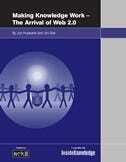 La Société Émergente du XXIe Siècle (The Emergent Society of the 21st Century) — Piktos, 2010 (tagging along on the coattails of Michel Cartier, the Quebecois version of Marshall McLuhan meets Alvin Toffler)
La Société Émergente du XXIe Siècle (The Emergent Society of the 21st Century) — Piktos, 2010 (tagging along on the coattails of Michel Cartier, the Quebecois version of Marshall McLuhan meets Alvin Toffler)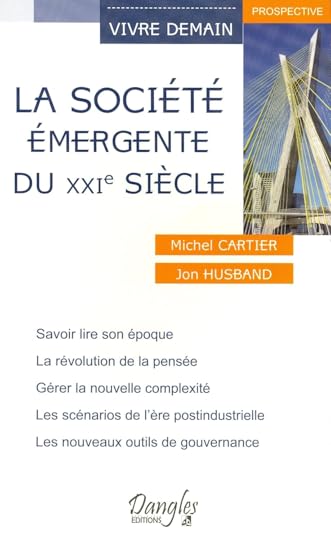 Wirearchy: Sketches for the Future of Work— French Edition
Wirearchy: Sketches for the Future of Work— French Edition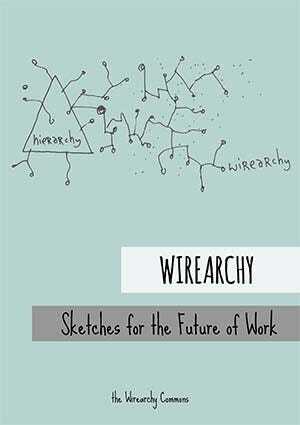 Working Smarter Fieldbook: September 2010 Edition edited by Jay Cross
Working Smarter Fieldbook: September 2010 Edition edited by Jay Cross Changing the World of Work. One Human at a Time. by Change Agents Worldwide
Changing the World of Work. One Human at a Time. by Change Agents Worldwide [image error]
[image error]
December 6, 2024
Knowledge Management Thought Leader 93: John Lewis
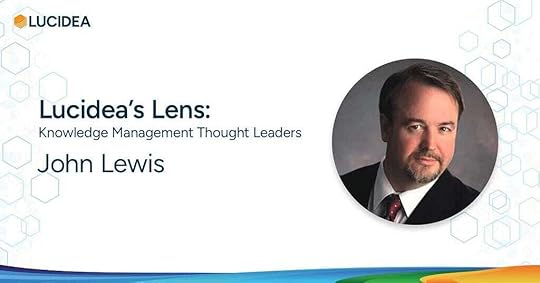
John Lewis is Chief Story Thinker, Owner, and CKO at Explanation Age LLC. He is a consultant, speaker, author, and coach on knowledge management, organizational learning, leadership, and story thinking.
His research interests are in cognitive psychology, educational psychology, and organizational psychology.
John is the former Chief Knowledge Officer at SearchBlox Software, Inc. He helps knowledge-driven organizations accelerate learning and transformational change. John has experience in change management strategies, specifically related to transactional leadership requirements, human capital requirements including innovation and skills training, knowledge management requirements for collaboration and self-service operations, and end-user experience for customers and associates.
Here are definitions for five of John’s specialties:
Change Management : Developing a planned approach to change in an organization to address anticipated obstacles and to ensure successful adoption. Collaboration : Interacting with peers and colleagues to exchange ideas, share experiences, work together on projects, and solve problems. Innovation : The process by which an idea is translated into a good or service for which people will pay.Organizational Learning : The capacity of the organization to acquire the knowledge necessary to survive and compete in its environment. Story Thinking: Storytelling is based on a sensemaking pattern for how we should talk, but Story Thinking is based on this sensemaking pattern for how we should work. Based on neuroscience, Story Thinking recognizes that everything is in a story (unlike storytelling, which communicates only about the past and envisions the future). It provides an approach to better execute the innate lesson cycle. Story Thinking as an operational concept provides new ways to identify innovative ideas and facilitate change and can lead to transformational leadership results through collaboration.
For more about John, see Profiles in Knowledge. John created the following content. I have curated it to represent his contributions to the field.
Books by John LewisThe Explanation Age: Inspiring Visualizations of the New Learning Organization
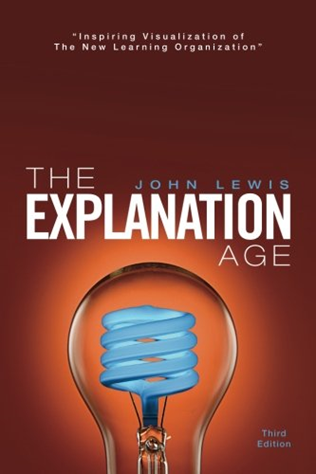
Story Thinking: Transforming Organizations for the Fourth Industrial Revolution
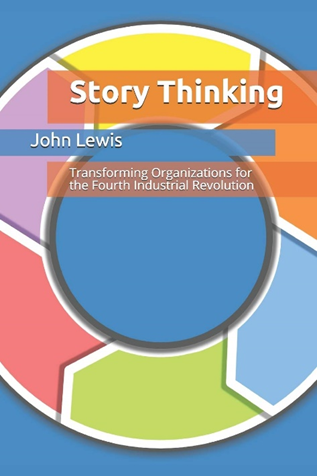
The Intelligent Social Change Journey: Foundation for the Possibilities that are YOU!
 The Symbiotic Table of Knowledge
The Symbiotic Table of KnowledgeWhat are the fundamental types of questions that humans ask?
What are the fundamental types of answers that humans expect?
Can we produce a table from these fundamental questions and answers?
YES! The Symbiotic Table of Knowledge:
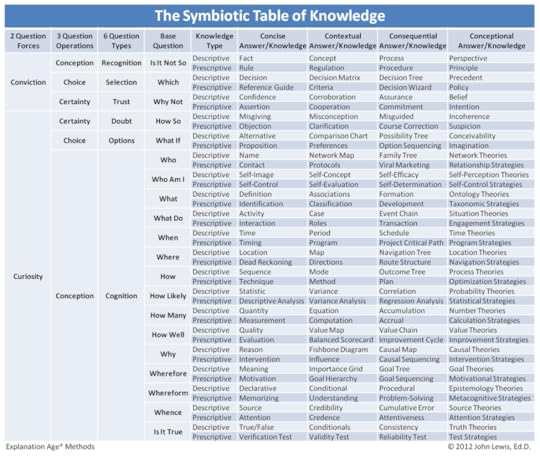 8 Degrees of Reason
8 Degrees of ReasonTo address reflective communication, collaborative decision making, and conflict resolution, we need to be able to accurately communicate the reasons behind our learnings and explanations. Behind every explanation ever given, there are only eight basic types of reasons. Answers range from “because I said so” to “because the empirical evidence supports the hypothesis,” or even “because I didn’t think to ask.”
As “mental misers,” we quench curiosity by accepting the reason with the least level of effort (cognitive demand) required. So the lower degrees are more efficient than higher degrees. For example, “because I wanted to” (first degree) is a reason that takes less effort than “because the hypothesis was confirmed” (seventh degree).
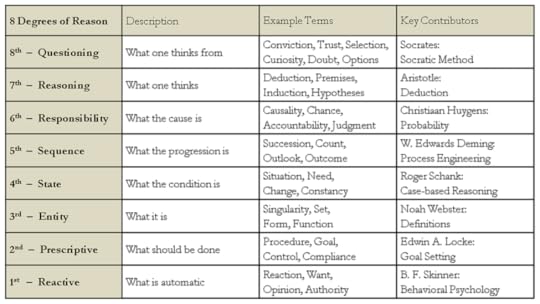 Story Thinking Cycle™ (Innate Lesson Cycle)
Story Thinking Cycle™ (Innate Lesson Cycle)6 Phases of ADIIEA

This cycle is the mind’s natural model for change and learning and is formed by the relationship of our workability beliefs (Does Work, Won’t Work, and Could Work) and our response modes (Reactive, Reflective, and Questioning). And this cycle contains six phases: Automation, Disruption, Investigation, Ideation, Expectation, and Affirmation, or simply called ADIIEA (pronounced uh-dee-uh). The location of each phase is like working against gravity; we tend to rest at the bottom and operate in automation, without much thought. This cycle is at play within every business project, every classroom lesson, and even for how a bill becomes a law.
Understanding this cycle allows us to evaluate each individual phase, and holistically manage an organization’s ability to prepare, innovate, change, and perform. And it allows us to connect the now-separate functions of Idea Management, Risk Management, and Operations Management:
Automation is where we manage proficiency through Operations Management and distinguish between simplicity and elegance.Disruption is where we manage preparedness through Risk Management, for problems as well as opportunities.Investigation is where we manage impartial analysis through Investigation Management, for inspections and explorations.Ideation is where we manage constructive ideas through Idea Management and seek both derivations and innovations.Expectation is where we manage realistic goals through Change Management, and act on what we put our hope and faith in.Affirmation is where we manage certainty through Quality and Assurance Management and distinguish between knowing and trusting.Methods from the last age were linear and prescriptive: Do-These-Steps-In-This-Order. ADIIEA is a method that is cyclic and descriptive. It provides the phases of thinking through a lesson, which allows for “rocking” between phases, but it begins and ends in our most natural state: automation.
[image error]November 23, 2024
Sharing and Subscribing

Another great week of KMWorld concluded yesterday. I want to take this opportunity to share some content and suggest four subscriptions.
KMWorld 2024PresentationsDownload Presentations for KMWorld 2024
My KM 101 Workshop slidesKnowledge Management 101 Workshop.pptx
https://medium.com/media/1688add7f2f3beaace56c960261c83e7/hrefBooksMy latest book is available as a free download: Profiles in Knowledge: 120 KM Thought LeadersProfiles in Knowledge: 120 Thought Leaders in Knowledge Management
My other booksBlog PostsOnly You Can Prevent Knowledge Loss: How to Practice “Knowledge Archaeology”Only You Can Prevent Knowledge Loss: How to Practice “Knowledge Archaeology”
How AI Can Support KM ProcessesHow AI Can Support KM Processes
What to Look for in Knowledge Management SoftwareWhat to Look for in Knowledge Management Software
Why Senior Leadership by Example is Important for Knowledge Management SuccessWhy Senior Leadership by Example is Important for Knowledge Management Success
Knowledge Curation: A Vital Element of KMKnowledge Curation: A Vital Element of KM
Subscribe to:SIKM Leaders Community: send a message to stangarfield@gmail.com to request membershipMy Monthly LinkedIn Newsletter: Profiles in KnowledgeProfiles in Knowledge | LinkedIn
My Medium BlogGet an email whenever Stan Garfield publishes a new blog post.
My Weekly Substack Newsletter: Fave Five — Books, Food, Music, Sports, and HumorFave Five | Stan Garfield | Substack
Knowledge Fika Podcast with Rebecka Isaksson of KnowFlow Value and Dawn Brushammar of Sugarworkhttps://medium.com/media/654547d7111cd3dbd4af4fe364e7dc18/href[image error]


